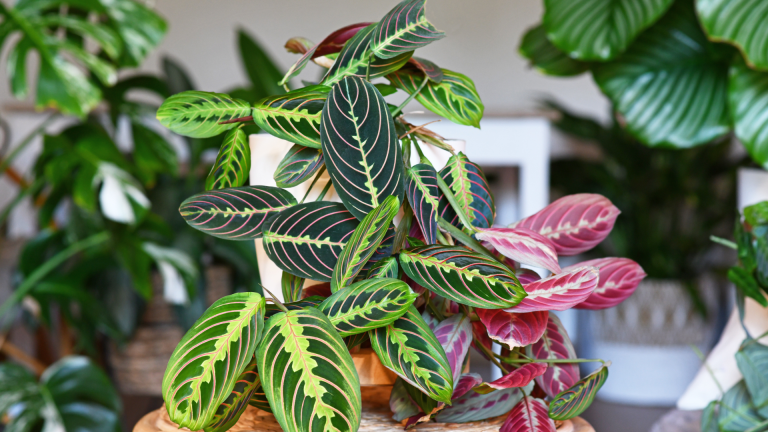Hello, plant lovers and green-thumb beginners! Welcome to our cozy corner of the plant world. If you’ve been eyeing those beautiful Calathea plants with their eye-catching leaf patterns, you’re in for a treat.
Calathea plants stand out with their bold patterns and unique habit of moving their leaves throughout the day (they even fold up at night!). These tropical beauties bring a touch of warmth to any room.
But these plants do much more than just sit pretty on your shelf. They can boost your health, lift your mood, and make your home a better place to live.
In this blog, I’ll show you different ways Calathea plants can improve your life. As plant experts with years of experience growing these beauties, we’ll help you understand why Calatheas deserve a spot in your home.
Surprising Key Benefits of Calathea Plants
I’ve grown Calathea plants for years and want to share their many benefits with you. These plants do more than just look good – they can truly enhance your home and well-being. Here’s what makes them special:
1. Air Purification
Calathea plants clean the air in your home by pulling toxins from it. They trap harmful particles and turn carbon dioxide into fresh oxygen. This helps you breathe better, especially if you live in a city or have allergies. Your lungs will thank you for adding these green helpers to your space.
2. Humidity Boosting
These plants release moisture into the air through a process called transpiration. This natural humidifier effect can help with dry skin, scratchy throats, and even reduce the risk of catching colds. I’ve noticed fewer static shocks in winter since adding Calatheas to my bedroom.
3. Stress Reduction
Caring for plants lowers stress levels – it’s backed by science! When you water and tend to your Calathea, your body releases chemicals that make you feel calm. The simple act of looking at their pretty leaves can help you unwind after a tough day.
4. Better Sleep Quality
Calatheas take in carbon dioxide at night and give out oxygen – the opposite of most plants. This means they’re perfect for bedrooms, as they help improve air quality while you sleep. I keep one on my nightstand and have noticed I wake up feeling more refreshed.
5. Natural Decor Element
The striking patterns on Calathea leaves add visual interest to any room. Their unique look fits many styles, from modern to bohemian. Unlike other decorations that collect dust, these living accents get more beautiful with time as they grow and change.
6. Mood Enhancement
Green plants like Calatheas can lift your spirits. Their vivid colors and patterns stimulate positive feelings. I look at my plant collection when I feel down, and their beauty helps shift my mood. They remind us of nature’s perfection even on gloomy days.
7. Increased Focus
Studies show that having plants in your workspace improves concentration and memory. The natural elements help your brain stay alert without causing stress. When I work near my Calatheas, I notice I can pay attention longer and think more clearly.
8. Pet-Friendly Choice
Unlike many houseplants, Calatheas are non-toxic to cats and dogs. You can enjoy their beauty without worrying about curious pets getting sick if they take a nibble. This peace of mind is worth a lot to animal lovers who want to keep a green home.
9. Low Light Tolerance
These plants thrive in spots that would kill other houseplants. They evolved on forest floors, so they’re used to filtered light. This makes them perfect for homes with few windows or north-facing apartments where sunshine is limited. They’re also highly adaptable, often requiring less maintenance than plants that need direct sunlight.
10. Natural Movements
Calatheas move their leaves up and down throughout the day, following the sun. This unique trait, called nyctinasty, makes them seem almost alive. I love watching my plants “wake up” in the morning as their leaves unfold to catch the light.
11. Weather Prediction
Changes in humidity and air pressure cause Calatheas to move their leaves differently. Some plant owners can tell when rain is coming by watching how their plants behave. This fun feature connects you more deeply to the natural world, even indoors.
12. Space Dividers
Larger Calathea varieties can act as natural room dividers. Place them in a row to section off areas in open-plan spaces. They add privacy without blocking light or making the room feel closed in – much nicer than a solid wall or screen. Their vibrant foliage also brings a touch of nature into your living space, enhancing the overall aesthetic.
13. Color Therapy
The rich greens, pinks, whites, and purples found on Calathea leaves offer a form of color therapy. These colors can affect your mood and energy. The varied shades bring balance to rooms with limited color and can complement your existing decor.
14. Teaching Tool for Kids
Calatheas make great first plants for children. Their movement sparks curiosity, and their care needs teach responsibility. I started my niece with a small Calathea, and she’s learned so much about biology watching it grow and respond to light. It’s also a fun way for kids to connect with nature and see firsthand how plants adapt to their environment.
15. Conversation Starter
These unusual plants draw attention and questions from visitors. Their striking looks and moving leaves make great talking points when you have guests. I’ve had many fun conversations start with someone asking, “What’s that amazing plant over there?”
How to Maximize the Benefits of Calathea Plants at Home?
Now that you know the many ways Calathea plants can improve your home, let’s talk about how to get the most from them.
I’ve learned these tips through years of caring for my own plant collection. Follow these simple steps to help your Calatheas thrive and boost their beneficial effects.
1. Choose the Right Location
Your Calathea will work hardest for you when placed in the right spot. Keep them away from direct sunlight, which can burn their leaves. Medium to low light areas are perfect. I put mine about 3-6 feet from east or north-facing windows.
The bathroom is actually a great place for Calatheas because of the higher humidity. In living areas, try to keep them away from heating vents or air conditioners that can dry them out. The plant’s leaves will tell you if it’s happy – flat, open leaves mean it’s content.
2. Water Properly
The right watering routine makes all the difference. Calatheas like their soil moist but not soggy. Wait until the top inch of soil feels dry, then water thoroughly until it runs from the drainage holes.
In winter, you’ll water less often than summer. I use room-temperature water because cold water can shock the roots. If possible, use filtered or rainwater since Calatheas are sensitive to chemicals in tap water. Proper watering helps the plant release more moisture into the air, boosting its humidifying benefits.
3. Maintain Humidity Levels
To get the full humidity-boosting benefits from your Calathea, help it along a bit. These plants love humidity of 50% or higher. Place a small humidifier nearby or group several plants together to create a mini moisture zone.
Another easy trick is to put your plant on a tray filled with pebbles and water. As the water evaporates, it increases humidity around the plant. Just make sure the pot sits on the pebbles, not in the water. When humidity is right, your plant will give more moisture back to your home.
4. Clean the Leaves Regularly
Dust on leaves blocks the plant’s ability to clean your air. Wipe the leaves gently with a damp cloth every two weeks. This not only keeps them looking bright but also helps them work better as air purifiers.
I’ve noticed my plants breathe easier after cleaning, and so do I! The dust that collects on houseplants is the same dust you’d otherwise breathe in. Clean leaves also absorb more light, which helps the plant stay healthy and continue providing benefits to your home.
5. Feed Seasonally
A well-fed Calathea gives more benefits. Use a gentle, balanced fertilizer diluted to half-strength during spring and summer when the plant is actively growing. I feed mine once a month during warm months and stop completely in winter.
Too much fertilizer can burn the roots and stress the plant, reducing its ability to purify air and release moisture. A little food goes a long way with these plants. When properly nourished, they produce more leaves and grow fuller, increasing all their beneficial effects.
How to Grow Calathea Plants for Health and Wellness?
Growing Calathea plants can boost your health and create a sense of calm in your home. I’ve found that these plants not only look beautiful but also help me feel better. Let me share some tips to help you grow Calatheas that will support your wellness goals.
1. Select the Right Variety for Your Needs
Not all Calatheas offer the same benefits. Choose based on what you need most. Calathea orbifolia has larger leaves that clean more air, while Calathea makoyana (Peacock Plant) has more leaf movement, which can be calming to watch.
For small spaces like apartments, try Calathea ornata (Pinstripe Plant) which stays compact. If you want a bolder look, Calathea medallion offers striking purple undersides. I started with just one variety but found that each brings something special to my home. Pick one that speaks to you both visually and for the specific benefits you want.
2. Create a Wellness-Focused Growing Area
Set up a spot in your home where you can group plants for maximum benefit. A small corner with a chair becomes a breathing space when surrounded by Calatheas. This creates a mini retreat for stress relief.
The key is making it a place you’ll actually use. I placed my plant corner near my reading spot so I spend time there daily. Add soft lighting and perhaps a small fountain for sound effects. This multi-sensory approach turns your plant area into a true wellness zone, helping you get more benefits from just being near your plants.
3. Use Organic Soil and Materials
To maximize health benefits, keep your plant care chemical-free. Choose organic potting soil without synthetic fertilizers. This creates a truly clean air-purifying system in your home.
I mix my own soil with coconut coir, organic compost, perlite, and a bit of charcoal. This blend holds moisture while allowing air to reach the roots. When your plant isn’t processing chemicals, it can focus energy on growth and air cleaning. Your lungs will thank you for the extra effort of going organic.
4. Match Care to Your Wellness Goals
Think about why you want this plant and tailor your care. If you want better sleep, place it in your bedroom and clean its leaves regularly to maximize oxygen production at night.
For stress relief, put your Calathea where you’ll see its movement throughout the day. The gentle leaf motion works as a natural mindfulness tool. For humidity benefits, group several in your most-used room. I align my plant care with what I need most from my plants, which makes both of us happier.
5. Practice Mindful Plant Care
Turn plant care into a wellness routine itself. When watering or cleaning leaves, slow down and be fully present. This creates a mini-meditation session in your day.
I check on my plants each morning for five minutes. This small ritual starts my day with calm focus and connection to nature. Notice the texture of the leaves, the subtle changes in color, and the new growth. This mindful approach turns basic plant care into a powerful wellness practice that benefits both you and your plant.
6. Monitor Indoor Air Quality
Your Calathea works hard to clean your air, but you can help it along. Reduce use of scented products, open windows when possible, and consider an air quality monitor to track improvements.
I noticed my plants seemed to struggle when I used a lot of cleaning products. Switching to natural cleaners helped both of us breathe easier. When you create a cleaner starting point, your plants can make a bigger difference in your air quality, which directly affects how you feel each day.
7. Create a Hydration Station
Both you and your Calathea need proper hydration for health. Place a water bottle or small pitcher near your plants as a reminder to drink water when you water them.
This simple habit pairing works wonderfully. Each time I water my plants, I refill my own glass. My plants stay healthy, and I stay hydrated. The visual connection between plant health and human health reinforces good habits for us both. Proper hydration improves skin, mood, and energy levels – for plants and people alike.
Conclusion
Calathea plants offer far more than just good looks. These leafy friends bring real benefits to your home and life—from cleaner air to better sleep and calmer thoughts.
Whether you’re a plant beginner or have a house full of green buddies, I hope this guide helps you see these plants in a new light. They’re not just pretty faces but hard workers that support your well-being every day.
Try adding just one Calathea to your space and watch what happens. Notice how it moves, grows, and changes your room’s feel. These small changes add up to big improvements in how you feel at home.
Remember to watch and listen to your plant’s needs. The care you give comes back to you many times over. As your Calathea thrives, you might find yourself thriving too, in ways you never expected from simply bringing home a new plant friend.
















